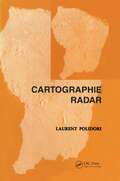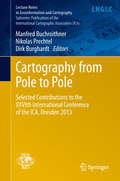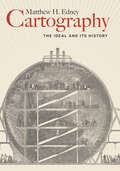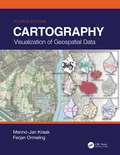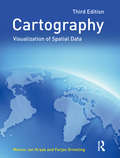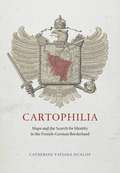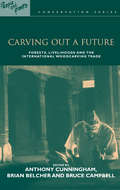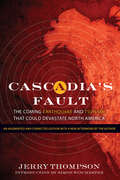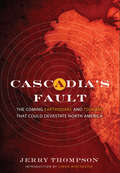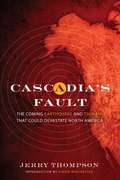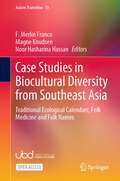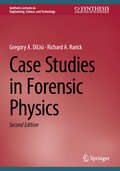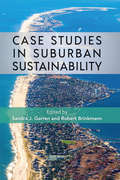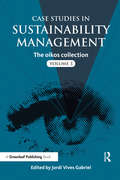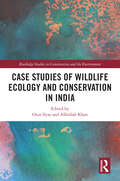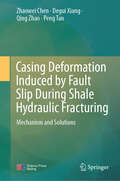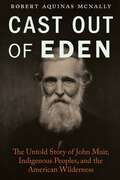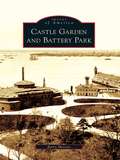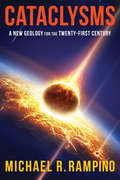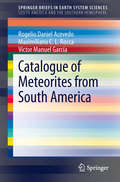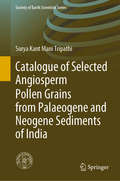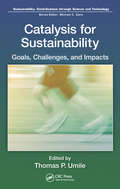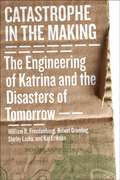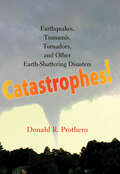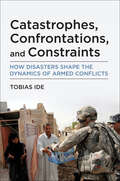- Table View
- List View
Cartographie Radar
by Laurent PolidoriFirst published in 2004. Ce livre fait le point sur les applications du radar, tant aeroporte que spatial, en cartographie. La cartographie topographique est le sujet principal de l'ouvrage qui se concentre en particulier sur la modelisation numerique de terrain par radargrammetrie, radarclinometrie et interferometrie. Les principales applications thematiques de l'imagerie radar sont egalement passees en revue et illustrees_. Destine aux utilisateurs et aux etudiants interesses par le domaine de l'imagerie radar (topographes, ingenieurs civils, geologues ... ) ce texte les informera sur les potentialites - et les Ii mites - de cette technique.
Cartography from Pole to Pole: Selected Contributions to the XXVIth International Conference of the ICA, Dresden 2013 (Lecture Notes in Geoinformation and Cartography #8)
by Dirk Burghardt Manfred Buchroithner Nikolas PrechtelThis volume comprehends a selection of papers presented during the 26th International Cartographic Conference held in Dresden from the 26th to the 30th of August 2013. It covers many fields of relevant Mapping and GIS research subjects, such as cartographic applications, cartographic tools, generalisation and update Propagation, higher dimensional visualisation and augmented reality, planetary mapping issues, cartography and environmental modelling, user generated content and spatial data infrastructure, use and usability as well as cartography and GIS in education.
Cartography: The Ideal and Its History (The\history Of Cartography Ser. #4)
by Matthew H. Edney“In his most ambitious work to date, [Edney] questions the very concept of ‘cartography’ to argue that this flawed ideal has hobbled the study of maps.” —Susan Schulten, author of A History of America in 100 MapsOver the past four decades, the volumes published in the landmark History of Cartography series have both chronicled and encouraged scholarship about maps and mapping practices across time and space. As the current director of the project that has produced these volumes, Matthew H. Edney has a unique vantage point for understanding what “cartography” has come to mean and include.In this book Edney disavows the term cartography, rejecting the notion that maps represent an undifferentiated category of objects for study. Rather than treating maps as a single, unified group, he argues, scholars need to take a processual approach that examines specific types of maps—sea charts versus thematic maps, for example—in the context of the unique circumstances of their production, circulation, and consumption. To illuminate this bold argument, Edney chronicles precisely how the ideal of cartography that has developed in the West since 1800 has gone astray. By exposing the flaws in this ideal, his book challenges everyone who studies maps and mapping practices to reexamine their approach to the topic. The study of cartography will never be the same.“[An] intellectually bracing and marvellously provocative account of how the mythical ideal of cartography developed over time and, in the process, distorted our understanding of maps.” —Times Higher Education“Cartography: The Ideal and Its History offers both a sharp critique of current practice and a call to reorient the field of map studies. A landmark contribution.” —Kären Wigen, coeditor of Time in Maps
Cartography: Visualization of Geospatial Data, Fourth Edition
by Menno-Jan Kraak Ferjan OrmelingThis Fourth Edition of Cartography: Visualization of Geospatial Data serves as an excellent introduction to general cartographic principles. It is an examination of the best ways to optimize the visualization and use of spatiotemporal data. Fully revised, it incorporates all the changes and new developments in the world of maps, such as OpenStreetMap and GPS (Global Positioning System) based crowdsourcing, and the use of new web mapping technology and adds new case studies and examples. Now printed in colour throughout, this edition provides students with the knowledge and skills needed to read and understand maps and mapping changes and offers professional cartographers an updated reference with the latest developments in cartography. Written by the leading scholars in cartography, this work is a comprehensive resource, perfect for senior undergraduate and graduate students taking courses in GIS (geographic information system) and cartography. New in This Edition: Provides an excellent introduction to general cartographic visualization principles through full-colour figures and images Addresses significant changes in data sources, technologies and methodologies, including the movement towards more open data sources and systems for mapping Includes new case studies and new examples for illustrating current trends in mapping Provides a societal and institutional framework in which future mapmakers are likely to operate, based on UN global development sustainability goals
Cartography: Visualization of Spatial Data
by Menno-Jan Kraak F. J. OrmelingThis revised and updated edition integrates the latest in modern technology with traditional cartographic principles. While providing a solid conceptual foundation in cartographic methodology, the text also introduces the very latest advances that have greatly influenced cartographic techniques. The new edition reflects the increasing importance of cartography as the basis for further geographical study, the text has been updated throughout and chapters on the latest developments in cartography have been integrated. There is also a more widespread emphasis on multimedia and the web.
Cartophilia: Maps and the Search for Identity in the French-German Borderland
by Catherine Tatiana DunlopThe period between the French Revolution and World War II was a time of tremendous growth in both mapmaking and map reading throughout Europe. There is no better place to witness this rise of popular cartography than in Alsace-Lorraine, a disputed borderland that the French and Germans both claimed as their national territory. Desired for its prime geographical position and abundant natural resources, Alsace-Lorraine endured devastating wars from 1870 to 1945 that altered its borders four times, transforming its physical landscape and the political allegiances of its citizens. For the border population whose lives were turned upside down by the French-German conflict, maps became essential tools for finding a new sense of place and a new sense of identity in their changing national and regional communities. Turning to a previously undiscovered archive of popular maps, Cartophilia reveals Alsace-Lorraine’s lively world of citizen mapmakers that included linguists, ethnographers, schoolteachers, hikers, and priests. Together, this fresh group of mapmakers invented new genres of maps that framed French and German territory in original ways through experimental surveying techniques, orientations, scales, colors, and iconography. In focusing on the power of "bottom-up” maps to transform modern European identities, Cartophilia argues that the history of cartography must expand beyond the study of elite maps and shift its emphasis to the democratization of cartography in the modern world.
Carving out a Future: "Forests, Livelihoods and the International Woodcarving Trade"
by Bruce M Campbell Brian Belcher Anthony CunninghamVery little has yet been written about the cultural or economic contributions of woodcarving to people's livelihoods or the consequences of felling hardwood and softwood trees for the international woodcarving trade. Carving Out a Future is the first examination of this trade and its critical links to rural livelihoods, biodiversity, conservation, forestry and the international trade regime. A range of case studies from Australia, Bali, India,Africa and Mexico provides a lens for examining the critical issues relating to the significant impacts of woodcarving on forests, conservation efforts, the need to promote sustainable rural livelihoods and efforts to promote trade so that skilled artisans in developing countries get a fair economic return. Livelihoods, Carving and Conservation * Global Overview * The Case of Woodcarving in Kenya * Drums and Hornbills * Sculpture and Identity * Carving Wood in Southern Zimbabwe * The Kiaat Woodcrafters of Bushbuckridge, South Africa * Carvers, Conservation and Certification in India * Colour, Sustainability and Market Sense in Bali * Aboriginal Woodcarvers in Australia * BurseraWoodcarving in Oaxaca, Mexico * Linaloe Wood Handicrafts * Learning from a Comparison of Cases * Carving, Sustainability and Scarcity * Certification of Woodcarving * Planning for Woodcarving in the 21st Century *
Cascadia's Fault: The Coming Earthquake and Tsunami that Could Devastate North America
by Simon Winchester Jerry ThompsonThere is a crack in the earth's crust that runs roughly 31 miles offshore, approximately 683 miles from Northern California up through Vancouver Island off the coast of British Columbia. The Cascadia Subduction Zone has generated massive earthquakes over and over again throughout geologic time-at least thirty-six major events in the last 10,000 years. This fault generates a monster earthquake about every 500 years. And the monster is due to return at any time. It could happen 200 years from now, or it could be tonight.The Cascadia Subduction Zone is virtually identical to the offshore fault that wrecked Sumatra in 2004. It will generate the same earthquake we saw in Sumatra, at magnitude nine or higher, sending crippling shockwaves across a far wider area than any California quake. Slamming into Sacramento, Portland, Seattle, Victoria, and Vancouver, it will send tidal waves to the shores of Australia, New Zealand, and Japan, damaging the economies of the Pacific Rim countries and their trading partners for years to come.In light of recent massive quakes in Haiti, Chile, and Mexico, Cascadia's Fault not only tells the story of this potentially devastating earthquake and the tsunamis it will spawn, it also warns us about an impending crisis almost unprecedented in modern history.
Cascadia's Fault: The Coming Earthquake and Tsunami that Could Devastate North America
by Jerry ThompsonThere is a crack in the earth's crust that runs roughly 31 miles offshore, approximately 683 miles from Northern California up through Vancouver Island off the coast of British Columbia. The Cascadia Subduction Zone has generated massive earthquakes over and over again throughout geologic time—at least thirty–six major events in the last 10,000 years. This fault generates a monster earthquake about every 500 years. And the monster is due to return at any time. It could happen 200 years from now, or it could be tonight.The Cascadia Subduction Zone is virtually identical to the offshore fault that wrecked Sumatra in 2004. It will generate the same earthquake we saw in Sumatra, at magnitude nine or higher, sending crippling shockwaves across a far wider area than any California quake. Slamming into Sacramento, Portland, Seattle, Victoria, and Vancouver, it will send tidal waves to the shores of Australia, New Zealand, and Japan, damaging the economies of the Pacific Rim countries and their trading partners for years to come.In light of recent massive quakes in Haiti, Chile, and Mexico, Cascadia's Fault not only tells the story of this potentially devastating earthquake and the tsunamis it will spawn, it also warns us about an impending crisis almost unprecedented in modern history.
Cascadia's Fault: The Earthquake and Tsunami That Could Devastate North America
by Simon Winchester Jerry ThompsonThere's a crack in the earth's crust that runs roughly 31 miles offshore, approximately 683 miles from northern California up through Vancouver Island off the coast of British Columbia. The Cascadia Subduction Zone has generated massive earthquakes over and over again throughout geologic time-at least 36 major events in the last 10,000 years. This fault generates a monster earthquake about every 500 years. And the monster is due to return at any time. It could happen 200 years from now, or it could be tonight. The Cascadia Subduction Zone is virtually identical to the offshore fault that wrecked Sumatra in 2004. It will generate the same earthquake we saw in Sumatra, at magnitude 9 or higher, sending crippling shockwaves across a far wider area than any California quake. Slamming into Sacramento, Portland, Seattle, Victoria, and Vancouver, it will send tidal waves to the shores of Australia, New Zealand, and Japan, damaging the economies of the Pacific Rim countries and their trading partners for years to come. In light of recent massive quakes in Haiti, Chile, and Mexico, Cascadia's Fault not only tells the story of this potentially devastating earthquake and the tsunamis it will spawn, it also warns us about the impending crisis almost unprecedented in modern history.
Case Studies in Biocultural Diversity from Southeast Asia: Traditional Ecological Calendars, Folk Medicine and Folk Names (Asia in Transition #19)
by Noor Hasharina Hassan F. Merlin Franco Magne KnudsenThis open access book demonstrates the linkages between local languages, traditional knowledge, and biodiversity at the landscape level in Asia, providing a fresh approach to discussions on Asia’s biocultural diversity. The book carries forward earlier analyses but importantly focuses on ‘traditional ecological calendars,’ ‘folk medicine,’ and ‘folk names’ in the context of the vital importance of maintaining biological, cultural, and linguistic diversity. It does this by addressing a range of cases and issues in relation to Southeast Asia: Brunei Darussalam, Indonesia, Malaysia, the Philippines, and North-East India. The several chapters demonstrate the ways in which the various forms of knowledge of the environment and its categorizations are important in areas such as landscape and resource management and conservation. They also demonstrate that environmental knowledge and the practical skills which accompany it are not necessarily widely shared. This book sends important messages to those who care about the sustainability of our environment, the maintenance of its biocultural diversity, or at least the maintenance of what remains of it because much has changed. This interdisciplinary collection draws from a wide range of disciplines and is of appeal to students and scholars in anthropology, environmental studies, geography, biodiversity, and linguistics.
Case Studies in Forensic Physics (Synthesis Lectures on Engineering, Science, and Technology)
by Gregory A. DiLisi Richard A. RarickThis book applies basic principles of physics to conduct forensics-style re-examinations of several historical events. The authors familarize readers with introductory-level physics while demonstrating how physics concepts can be utilized to resolve historical debates about unsolved mysteries and controversial events. Each chapter introduces a new physics concept, then applies that concept to case studies in detail. The authors also identify the advantages of using case studies as a pedagogical approach to understanding physics. This second edition expands the number of physics principles and case studies covered. The book provides readers with the tools of a good forensic physicist and the ability to utilize them for real-world applications.
Case Studies in Suburban Sustainability
by Sandra J. Garren and Robert BrinkmannThe first volume to focus on suburbs and sustainability in the United States, this collection approaches the topic through regionally diverse case studies. Departing from the more widely examined issue of urban sustainability, contributors argue that the suburbs present a unique and important challenge given their greater land mass, lower population density, lower tax rates, and more limited government services. The studies featured in this volume analyze the impact of planning, social and economic concerns, environmental factors such as air pollution and climate change, and water management on suburban communities. Areas of focus include suburbs of New York City, Seattle, Pittsburgh, Los Angeles, Phoenix, New Orleans, and Tampa. In these examples, contributors show that activism and leadership are currently advancing a strong sustainability agenda in regions many would have believed unlikely. Through these case studies, this volume demonstrates that the suburbs are a crucial nexus for sustainability in the United States. Because suburbs have been overlooked in most green initiatives, and because they play such a vital role in the future of American housing and development, these essays call for more research and continued creative innovation in these areas. Contributors: Troy D. Abel | Simon A. Andrew | Viney P. Aneja | Miles Ballogg | William H. Battye | Casey D. Bray | Vaswati Chatterjee | Stacy Clauson | Craig E. Colten | Sarah Combs | Yonn Dierwechter | Richard C. Feiock | Michael H. Finewood | Melissa M. Grigione | John Harner | Mathew K. Huxel | Mike Johnson | Gabrielle R. Lehigh | Elizabeth Mattiuzzi | Sean McGreevey | Susan M. Opp | Michaela C. Peterson | Benjamin L. Ruddell | Richard R. Rushforth | Debra Salazar | Ronald Sarno | Mallory Thomas | Carolina A. Urrea | Pornpan Uttamang | E. Christian Wells
Case Studies in Sustainability Management: The oikos collection Vol. 3
by Jordi Vives GabrielWith the rapidly growing importance of sustainability and corporate responsibility in a globalised world, management schools are increasingly integrating long-term economic, environmental and social issues into their teaching and research. Climate change, poverty, labour standards and human rights are among the many topics that future decision-makers will need to face in their careers. Business education needs to reflect this new reality and provide a broadened understanding of value creation in order to create economic capital while developing social and preserving natural capital. Case studies can be important tools for creating learning processes on different levels - students are forced to struggle with exactly the kinds of decisions and dilemmas managers confront every day. In this reflection of reality, the values and goals of the student are systematically challenged. This can be especially valuable in the context of sustainability management - organisations are now continually forced to value the different aspects of sustainability and their interrelations: How do social issues impact the economic bottom line? How can an environmentally sound strategy create a positive impact on employee motivation and thus have measurable impact on economic performance? What comes first and why? This third collection of oikos case studies is based on the winning cases from the 2010 to 2013 annual case competition. So what makes an excellent case in sustainability management? These cases have been highly praised because they provide excellent learning opportunities, tell engaging stories, deal with recent situations, include quotations from key actors, are thought-provoking and controversial, require decision-making and provide clear take-aways. These cases are clustered in three different sections: "Large Corporations and Corporate Sustainability Dilemmas" , "Managing Stakeholder Relations" and "Sustainability as a Source of Differentiation Strategies".Case Studies in Sustainability Management will be an essential purchase for educators and is likely to be a widely used as a course textbook at all levels of management education. Online Teaching Notes to accompany each chapter are available on request with the purchase of the book.
Case Studies of Wildlife Ecology and Conservation in India (Routledge Studies in Conservation and the Environment)
by Orus Ilyas and Afifullah KhanThis volume brings together a collection of case studies examining wildlife ecology and conservation across India. The book explores and examines a wide range of fauna across different terrains and habitats in India, revealing key issues and concerns for biodiversity conservation, with a particular emphasis on the impact of humans and climate change. Cases are as wide ranging as tigers, leopards, sloth bears, pheasants, insects and birds, across a diverse range of landscapes, including forests, wetlands, nature reserves and even a university campus. Split into three parts, Part I focuses on how the distribution of animals is influenced by the availability of resources such as food, water, and space. Chapters examine key determinants, such as diet and prey and habitat preferences, with habitat loss also being an important factor. In Part II, chapters examine human-wildlife interactions, dealing with issues such as the impact of urbanization, the establishment of nature reserves and competition for resources. The book concludes with an examination of landscape ecology and conservation, with chapters in Part III focusing on habitat degradation, changes in land-use patterns and ecosystem management. Overall, the volume not only reflects the great breadth and depth of biodiversity in India, but offers important insights to the challenges facing biodiversity conservation not only in this region, but worldwide. This volume will be of great interest to students and scholars of wildlife ecology, conservation biology, biodiversity conservation and the environmental sciences more broadly.
Casing Deformation Induced by Fault Slip During Shale Hydraulic Fracturing: Mechanism and Solutions
by Qing Zhao Zhaowei Chen Degui Xiang Peng TanThis book systematically clarifies the casing deformation prevention and control technologies based on the integration of research area of both geology and engineering. These technologies incorporate reservoir geomechanics, casing deformation mechanics and hydraulic fracturing mechanics. It covers fluid channel-fault activation model and casing deformation mechanisms, types and formation conditions of fluid channels, casing deformation risk prediction technology, casing deformation early warning technology based on microseismic and fracturing treatment curves, casing deformation control technology based on hydraulic fracturing simulation and casing deformation prevention strategy. This book is a valuable reference for both technical personnel and graduate students working in petroleum engineering, rock mechanics and reservoir geomechanics.
Cast Out of Eden: The Untold Story of John Muir, Indigenous Peoples, and the American Wilderness
by Robert Aquinas McNallyJohn Muir is widely and rightly lauded as the nature mystic who added wilderness to the United States&’ vision of itself, largely through the system of national parks and wild areas his writings and public advocacy helped create. That vision, however, came at a cost: the conquest and dispossession of the tribal peoples who had inhabited and managed those same lands, in many cases for millennia. Muir argued for the preservation of wild sanctuaries that would offer spiritual enlightenment to the conquerors, not to the conquered Indigenous peoples who had once lived there. &“Somehow,&” he wrote, &“they seemed to have no right place in the landscape.&”Cast Out of Eden tells this neglected part of Muir&’s story—from Lowland Scotland and the Wisconsin frontier to the Sierra Nevada&’s granite heights and Alaska&’s glacial fjords—and his take on the tribal nations he encountered and embrace of an ethos that forced those tribes from their homelands. Although Muir questioned and worked against Euro-Americans&’ distrust of wild spaces and deep-seated desire to tame and exploit them, his view excluded Native Americans as fallen peoples who stained the wilderness&’s pristine sanctity. Fortunately, in a transformation that a resurrected and updated Muir might approve, this long-standing injustice is beginning to be undone, as Indigenous nations and the federal government work together to ensure that quintessentially American lands from Bears Ears to Yosemite serve all Americans equally.
Castle Garden and Battery Park (Images of America)
by Barry MorenoFew buildings in Manhattan have had a richer and more varied life than 200-year-old Castle Clinton, the magnificent red sandstone structure that lies in historic Battery Park. Although originally built as a fortress just before the outbreak of the War of 1812, its actual fame rests on the years when it was known worldwide as Castle Garden, a name that underlined its intimate connection with the surrounding park. Under that name, it served successively as Manhattan's preeminent public events hall and theater (1824-1855), then as America's first great landing place for millions of immigrants (1855-1890), and finally as the oldest and grandest municipal aquarium in the United States (1896-1941). Castle Garden and Battery Park invites readers to step back in time and dip into this legendary monument's dramatic story and learn how it has managed to survive into the 21st century.
Cataclysms: A New Geology for the Twenty-First Century
by Michael RampinoIn 1980, the science world was stunned when a maverick team of researchers proposed that a massive meteor strike had wiped the dinosaurs and other fauna from the Earth 66 million years ago. Scientists found evidence for this theory in a “crater of doom” on the Yucatán Peninsula, showing that our planet had once been a target in a galactic shooting gallery. In Cataclysms, Michael R. Rampino builds on the latest findings from leading geoscientists to take “neocatastrophism” a step further, toward a richer understanding of the science behind major planetary upheavals and extinction events.Rampino recounts his conversion to the impact hypothesis, describing his visits to meteor-strike sites and his review of the existing geological record. The new geology he outlines explicitly rejects nineteenth-century “uniformitarianism,” which casts planetary change as gradual and driven by processes we can see at work today. Rampino offers a cosmic context for Earth’s geologic evolution, in which cataclysms from above in the form of comet and asteroid impacts and from below in the form of huge outpourings of lava in flood-basalt eruptions have led to severe and even catastrophic changes to the Earth’s surface. This new geology sees Earth’s position in our solar system and galaxy as the keys to understanding our planet’s geology and history of life. Rampino concludes with a controversial consideration of dark matter’s potential as a triggering mechanism, exploring its role in heating Earth’s core and spurring massive volcanism throughout geologic time.
Catalogue of Meteorites from South America (SpringerBriefs in Earth System Sciences)
by Rogelio Daniel Acevedo Maximiliano C. L. Rocca Víctor Manuel GarcíaThe first Catalogue of Meteorites from South America includes new specimens never previously reported, while doubtful cases and pseudometeorites have been deliberately omitted. The falling of these objects is a random event, but the sites where old meteorites are found tend to be focused in certain areas, e. g. in the deflation surfaces in Chile's Atacama Desert, due to favorable climate conditions and ablation processes. Our Catalogue provides basic information on each specimen like its provenance and the place where it was discovered (in geographic co-ordinates and with illustrative maps), its official name, its classification type (class, and if applicable, weathering grade and shock stage), if it was seen falling or was found by chance, its total mass or weight, the institution where it is held, and the most important bibliographic references about it.
Catalogue of Selected Angiosperm Pollen Grains from Palaeogene and Neogene Sediments of India (Society of Earth Scientists Series)
by Surya Kant TripathiThis book summarizes the taxonomic details of selected fossil angiosperm pollen genera and species along with their affinity and occurrences in space and time. It provides information about the historical background of palynology from Palaeogene and Neogene sediments in India, general pollen morphology along with the terms commonly used in describing fossil angiosperm pollen and an overview of the Indian Tertiary sediments. A complete list of genera described in this book is given. It also includes a key for identification of Indian angiosperm genera as well as a description of selected fossil angiosperm pollen from India along with their Indian records, illustrations, locality, age and horizon from where these have been reported. In all 130 genera and 402 species have been dealt with. The names of genera and species are arranged alphabetically. The Discussion part includes a summarized account of palynofloras, their biostratigraphic application in various regions of India and their palaeogeographical and palaeoclimatic implications.
Catalysis for Sustainability: Goals, Challenges, and Impacts (ISSN)
by Thomas P. UmileCatalysis for Sustainability: Goals, Challenges, and Impacts explores the intersection between catalytic science and sustainable technologies as a means to addressing current economic, social, and environmental problems. These problems include harnessing alternative energy sources, pollution prevention and remediation, and the manufacturing of comm
Catastrophe in the Making: The Engineering of Katrina and the Disasters of Tomorrow
by Shirley Laska William R. Freudenburg Robert B. Gramling Kai EriksonWhen houses are flattened, towns submerged, and people stranded without electricity or even food, we attribute the suffering to "natural disasters" or "acts of God." But what if they're neither? What if we, as a society, are bringing these catastrophes on ourselves? That's the provocative theory of Catastrophe in the Making, the first book to recognize Hurricane Katrina not as a "perfect storm," but a tragedy of our own making--and one that could become commonplace. The authors, one a longtime New Orleans resident, argue that breached levees and sloppy emergency response are just the most obvious examples of government failure. The true problem is more deeply rooted and insidious, and stretches far beyond the Gulf Coast. Based on the false promise of widespread prosperity, communities across the U.S. have embraced all brands of "economic development" at all costs. In Louisiana, that meant development interests turning wetlands into shipping lanes. By replacing a natural buffer against storm surges with a 75-mile long, obsolete canal that cost hundreds of millions of dollars, they guided the hurricane into the heart of New Orleans and adjacent communities. The authors reveal why, despite their geographic differences, California and Missouri are building--quite literally--toward similar destruction. Too often, the U.S. "growth machine" generates wealth for a few and misery for many. Drawing lessons from the most expensive "natural" disaster in American history, Catastrophe in the Making shows why thoughtless development comes at a price we can ill afford.
Catastrophes!: Earthquakes, Tsunamis, Tornadoes, and Other Earth-Shattering Disasters
by Donald R. ProtheroDevastating natural disasters have profoundly shaped human history, leaving us with a respect for the mighty power of the earth—and a humbling view of our future. Paleontologist and geologist Donald R. Prothero tells the harrowing human stories behind these catastrophic events.Prothero describes in gripping detail some of the most important natural disasters in history:• the New Madrid, Missouri, earthquakes of 1811–1812 that caused church bells to ring in Boston• the 2004 Indian Ocean tsunami that killed more than 230,000 people• the massive volcanic eruptions of Krakatau, Mount Tambora, Mount Vesuvius, Mount St. Helens, and Nevado del RuizHis clear and straightforward explanations of the forces that caused these disasters accompany gut-wrenching accounts of terrifying human experiences and a staggering loss of human life. Floods that wash out whole regions, earthquakes that level a single country, hurricanes that destroy everything in their path—all are here to remind us of how little control we have over the natural world. Dramatic photographs and eyewitness accounts recall the devastation wrought by these events, and the people—both heroes and fools—that are caught up in the earth's relentless forces. Eerie, fascinating, and often moving, these tales of geologic history and human fortitude and folly will stay with you long after you put the book down.
Catastrophes, Confrontations, and Constraints: How Disasters Shape the Dynamics of Armed Conflicts
by Tobias IdeA ground-breaking study on how natural disasters can escalate or defuse wars, insurgencies, and other strife.Armed conflict and natural disasters have plagued the twenty-first century. Not since the end of World War II has the number of armed conflicts been higher. At the same time, natural disasters have increased in frequency and intensity over the past two decades, their impacts worsened by climate change, urbanization, and persistent social and economic inequalities. Providing the first comprehensive analysis of the interplay between natural disasters and armed conflict, Catastrophes, Confrontations, and Constraints explores the extent to which disasters facilitate the escalation or abatement of armed conflicts—as well as the ways and contexts in which combatants exploit these catastrophes.Tobias Ide utilizes both qualitative insights and quantitative data to explain the link between disasters and the (de-)escalation of armed conflict and presents over thirty case studies of earthquakes, droughts, floods, and storms in Africa, the Middle East, Asia, and Latin America. He also examines the impact of COVID-19 on armed conflicts in Iraq, Afghanistan, Nigeria, and the Philippines.Catastrophes, Confrontations, and Constraints is an invaluable addition to current debates on climate change, environmental stress, and security. Professionals and students will greatly appreciate the wealth of timely data it provides for their own investigations.
